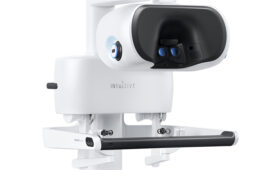
This sensor can measure blood glucose levels noninvasively by shining near-infrared light through the skin and measuring the chemical composition of the tissue below. (Image by Jeon Woong Kang)
Scientists at the Massachusetts Institute of Technology (MIT) have shown that they can use a type of spectroscopy to replace finger sticks to measure blood glucose levels.
Patients with diabetes must test those levels several times a day and more than half of patients don’t test often enough, in part because of the pain and inconvenience of the needle prick, according to studies cited by MIT.
Raman spectroscopy is a noninvasive technique that reveals the chemical composition of tissue, by analyzing how near-infrared light is scattered, or deflected, as it encounters different kinds of molecules. Until now, glucose levels had to be calculated indirectly, based on a comparison between Raman signals and a reference measurement of blood glucose levels. MIT scientists have shown that they can use it to directly measure glucose concentrations through the skin, according to the university.
While more work is needed to develop the technology into a user-friendly device, this advance shows that a Raman-based sensor for continuous glucose monitoring could be feasible, said Peter So, director of MIT’s Laser Biomedical Research Center, in a news release. An article on the study appears in Science Advances.
The near-infrared laser beam used for Raman spectroscopy can only penetrate a few millimeters into tissue. MIT researchers devised a way to correlate glucose measurements from the fluid that bathes skin cells, known as interstitial fluid, to blood glucose levels. But the signal produced by glucose tends to get drowned out by the many other tissue components found in skin.
“When you are measuring the signal from the tissue, most of the strong signals are coming from solid components such as proteins, lipids, and collagen,” said co-lead author Jeon Woong Kang, a research scientist at MIT. “Glucose is a tiny, tiny amount out of the total signal. Because of that, so far we could not actually see the glucose signal from the measured signal.”
The MIT team developed an approach that lets them see the glucose signal directly. They shine near-infrared light onto the skin at about a 60-degree angle, but collect the resulting Raman signal from a fiber perpendicular to the skin. This results in a stronger overall signal because the glucose Raman signal can be collected while unwanted reflected signal from the skin surface is filtered out, according to the university.
The researchers tested the system in pigs and found that after 10 to 15 minutes of calibration, they could get accurate glucose readings for up to an hour. They verified the readings by comparing them to glucose measurements taken from blood samples.
The researchers plan to work on shrinking the device, which is about the size of a desktop printer, so that it could be portable, in hopes of testing such a device on diabetic patients.
“You might have a device at home or a device in your office that you could put your finger on once in a while, or you might have a probe that you hold to your skin,” So said. “That’s what we’re thinking about in the shorter term.”
In the long term, they hope to create a wearable monitor that could offer continuous glucose measurements.



![A photo of the Medtronic GI Genius ColonPro polyp detection system flagging a potential sign of colon cancer during a colonoscopy. [Photo courtesy of Medtronic]](https://www.medicaldesignandoutsourcing.com/wp-content/uploads/2024/04/Medtronic-GI-Genius-doctors-268x170.jpg)
